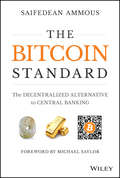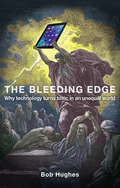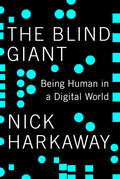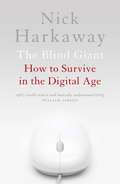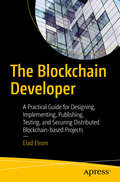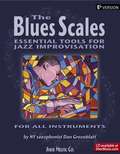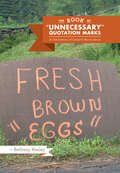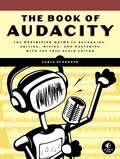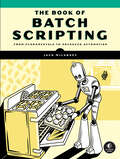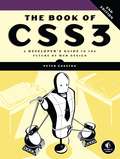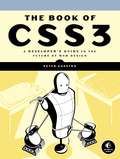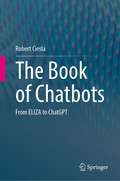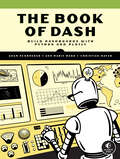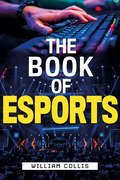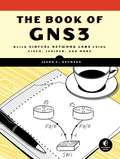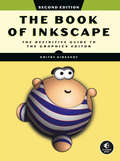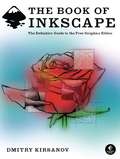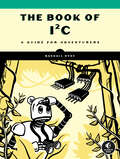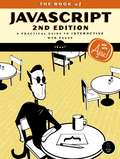- Table View
- List View
The Bitcoin Standard: The Decentralized Alternative to Central Banking
by Saifedean AmmousWhen a pseudonymous programmer introduced “a new electronic cash system that’s fully peer-to-peer, with no trusted third party” to a small online mailing list in 2008, very few paid attention. Ten years later, and against all odds, this upstart autonomous decentralized software offers an unstoppable and globally-accessible hard money alternative to modern central banks. The Bitcoin Standard analyzes the historical context to the rise of Bitcoin, the economic properties that have allowed it to grow quickly, and its likely economic, political, and social implications.
The Bite in the Apple: A Memoir of My Life with Steve Jobs
by Chrisann BrennanAn intimate look at the life of Steve Jobs by the mother of his first child providing rare insight into Jobs's formative, lesser-known years.Steve Jobs was a remarkable man who wanted to unify the world through technology. For him, the point was to set people free with tools to explore their own unique creativity. Chrisann Brennan knows this better than anyone. She met him in high school, at a time when Jobs was passionately aware that there was something much bigger to be had out of life, and that new kinds of revelations were within reach.The Bite in the Apple is the very human tale of Jobs's ascent and the toll it took, told from the author's unique perspective as his first girlfriend, co-parent, friend, and—like many others—object of his cruelty. Brennan writes with depth and breadth, and she doesn't buy into all the hype. She talks with passion about an idealistic young man who was driven to change the world, about a young father who denied his own child, and about a man who mistook power for love. Chrisann Brennan's intimate memoir provides the reader with a human dimension to Jobs' myth. Finally, a book that reveals a more real Steve Jobs.
The Bleeding Edge: Why Technology Turns Toxic in an Unequal World
by Bob HughesIt’s hammered into us from birth that ‘all good things come at a price’. Today, that price looks apocalyptic, with wars, exploitation and environmental collapse in every part of the globe. Some suggest that the carnage is “a price worth paying” for technological progress. No pain, no gain. But technology is precisely the business of minimising the costs and impacts of existence… and by whole orders of magnitude. By now, all human beings should be leading creative, leisure-filled lives in a pristine world of burgeoning diversity. So how did it go so wrong? In a word, inequality. In The Bleeding Edge, Bob Hughes argues that unequal societies are incapable of using new technologies well. Wherever elites exist, self-preservation decrees that they must take control of new technologies to protect and entrench their status, rather than satisfy people’s needs. Hughes pursues the latest discoveries about the effects of social inequality on human health, into the field of human environmental impact, and traces today’s ecological crisis back to the rise of the world’s first elites, 5,000 years ago. He argues that new technologies have never emerged from elites or from the clash of competitive forces, but from largely voluntary, egalitarian collaborations of the kind that produced the world’s first working computers. Finally, Hughes shows that an egalitarian world is not ‘pie in the sky' but our evolutionary homeland, the glue that holds societies together, and the “cradle of invention” from which all our best ideas emerge. The book concludes: ‘Let’s assume that the commitment to human equality that’s written into the Universal Declaration of Human Rights means exactly what it says, and take it from there.’
The Blender Python API
by Chris ConlanUnderstand Blender's Python API to allow for precision 3D modeling and add-on development. Follow detailed guidance on how to create precise geometries, complex texture mappings, optimized renderings, and much more.This book is a detailed, user-friendly guide to understanding and using Blender’s Python API for programmers and 3D artists. Blender is a popular open source 3D modeling software used in advertising, animation, data visualization, physics simulation, photorealistic rendering, and more. Programmers can produce extremely complex and precise models that would be impossible to replicate by hand, while artists enjoy numerous new community-built add-ons.The Blender Python API is an unparalleled programmable visualization environment. Using the API is made difficult due to its complex object hierarchy and vast documentation. Understanding the Blender Python API clearly explains the interface. You will become familiar with data structures and low-level concepts in both modeling and rendering with special attention given to optimizing procedurally generated models. In addition, the book:Discusses modules of the API as analogs to human input modes in BlenderReviews low-level and data-level manipulation of 3D objects in Blender PythonDetails how to deploy and extend projects with external librariesProvides organized utilities of novel and mature API abstractions for general use in add-on developmentWhat You’ll LearnGenerate 3D data visualizations in Blender to better understand multivariate data and mathematical patterns.Create precision object models in Blender of architectural models, procedurally generated landscapes, atomic models, etc.Develop and distribute a Blender add-on, with special consideration given to careful development practicesPick apart Blender’s 3D viewport and Python source code to learn about API behaviorsDevelop a practical knowledge of 3D modeling and rendering conceptsHave a practical reference to an already powerful and vast APIWho This Book Is ForPython programmers with an interest in data science, game development, procedural generation, and open-source programming as well as programmers of all types with a need to generate precise 3D models. Also for 3D artists with an interest in programming or with programming experience and Blender artists regardless of programming experience.
The Blind Giant
by Nick HarkawayNick Harkaway, author of Angelmaker, presents a rousing and energizing look at how we can meaningfully and constructively engage with technology--creating an essential handbook for anyone trying to be human in a digital age. Some say our devices will lead us to ruin: isolating us from our neighbors, warping communication, delivering an unregulated flood of information that will destroy our humanity. Some say they will be our salvation: enabling global communication and social engagement, putting all the world's facts at our fingertips, and erasing the barriers that divide us, bringing out the best qualities of humanity. In The Blind Giant, novelist and blogger Nick Harkaway takes us on a lucid, insightful and personal tour of how we live our lives in our technology-obsessed culture. A self-described "missing link" between the pre-Internet generation and the "digital natives" who have grown up with technology, Nick is an enthusiastic guide to digital culture who weaves together examples from literature, psychology, neurology, sociology, history, and his own life while exploring the hazards and joys of the human-machine relationship. In the final analysis, whether we meaningfully engage with the machines we have created, or risk living in a world which is designed to serve computers and corporations rather than people, this book is a must-read for anyone concerned with our digital future.
The Blind Giant: How to Survive in the Digital Age
by Nick HarkawayThe digital age. An age of isolation, warped communication, disintegrating community. Where unfiltered and unregulated information pours relentlessly into our lives, destroying what it means to be human. Or an age of marvels. Where there is a world of wonder at our fingertips. Where we can communicate across the globe, learn in the blink of an eye, pull down the barriers that divide us and move forward together. Whatever your reaction to technological culture, the speed with which our world is changing is both mesmerising and challenging. In The Blind Giant, novelist and tech blogger Nick Harkaway draws together fascinating and disparate ideas to challenge the notion that digital culture is the source of all our modern ills, while at the same time showing where the dangers are real and suggesting how they can be combated. Ultimately, the choice is ours: engage with the machines that we have created, or risk creating a world which is designed for corporations and computers rather than people. This is an essential handbook for everyone trying to be human in a digital age.
The Blind Giant: How to Survive in the Digital Age
by Nick HarkawayThe digital age. An age of isolation, warped communication, disintegrating community. Where unfiltered and unregulated information pours relentlessly into our lives, destroying what it means to be human. Or an age of marvels. Where there is a world of wonder at our fingertips. Where we can communicate across the globe, learn in the blink of an eye, pull down the barriers that divide us and move forward together. Whatever your reaction to technological culture, the speed with which our world is changing is both mesmerising and challenging. In The Blind Giant, novelist and tech blogger Nick Harkaway draws together fascinating and disparate ideas to challenge the notion that digital culture is the source of all our modern ills, while at the same time showing where the dangers are real and suggesting how they can be combated. Ultimately, the choice is ours: engage with the machines that we have created, or risk creating a world which is designed for corporations and computers rather than people. This is an essential handbook for everyone trying to be human in a digital age.
The Blockchain Developer: A Practical Guide for Designing, Implementing, Publishing, Testing, and Securing Distributed Blockchain-based Projects
by Elad ElromBecome a Blockchain developer and design, build, publish, test, maintain and secure scalable decentralized Blockchain projects using Bitcoin, Ethereum, NEO, EOS and Hyperledger. This book helps you understand Blockchain beyond development and crypto to better harness its power and capability. You will learn tips to start your own project, and best practices for testing, security, and even compliance. Immerse yourself in this technology and review key topics such as cryptoeconomics, coding your own Blockchain P2P network, different consensus mechanisms, decentralized ledger, mining, wallets, blocks, and transactions. Additionally, this book provides you with hands-on practical tools and examples for creating smart contracts and dApps for different blockchains such as Ethereum, NEO, EOS, and Hyperledger. Aided by practical, real-world coding examples, you’ll see how to build dApps with Angular utilizing typescript from start to finish, connect to the blockchain network locally on a test network, and publish on the production mainnet environment. Don’t be left out of the next technology revolution – become a Blockchain developer using The Blockchain Developer today. What You’ll Learn Explore the Blockchain ecosystem is and the different consensus mechanismsCreate miners, wallets, transactions, distributed networks and DAppsReview the main features of Bitcoin: Ethereum, NEO and EOS, and Hyperledger areInteract with popular node clients as well as implementing your own BlockchainPublish and test your projects for security and scalability Who This Book Is For Developers, architects and engineers who are interested in learning about Blockchain or implementing Blockchain into a new greenfield project or integrating Blockchain into a brownfield project. Technical entrepreneurs, technical investors or even executives who want to better understand Blockchain technology and its potential.
The Blockchain and the New Architecture of Trust (Information Policy)
by Kevin WerbachHow the blockchain—a system built on foundations of mutual mistrust—can become trustworthy.The blockchain entered the world on January 3, 2009, introducing an innovative new trust architecture: an environment in which users trust a system—for example, a shared ledger of information—without necessarily trusting any of its components. The cryptocurrency Bitcoin is the most famous implementation of the blockchain, but hundreds of other companies have been founded and billions of dollars invested in similar applications since Bitcoin's launch. Some see the blockchain as offering more opportunities for criminal behavior than benefits to society. In this book, Kevin Werbach shows how a technology resting on foundations of mutual mistrust can become trustworthy. The blockchain, built on open software and decentralized foundations that allow anyone to participate, seems like a threat to any form of regulation. In fact, Werbach argues, law and the blockchain need each other. Blockchain systems that ignore law and governance are likely to fail, or to become outlaw technologies irrelevant to the mainstream economy. That, Werbach cautions, would be a tragic waste of potential. If, however, we recognize the blockchain as a kind of legal technology that shapes behavior in new ways, it can be harnessed to create tremendous business and social value.
The Blues Scales - Eb Version
by Sher Music Dan GreenblattThe only book that shows how the Blues Scales (Major and Minor) are used to create jazz solos. Designed to help beginners quickly learn how to create meaningful solos without having to first master all the scales and chords of a tune. Great transcriptions of solo phrases by Miles Davis, Dave Sanborn, Dizzy Gillespie, etc. showing how the Blues Scales are used. The accompanying CD has the author and his NY rhythm section demonstrating each exercise, and also great as a jazz play-along! Endorsed by Michael Brecker, Jamey Aebersold, etc.
The Book of "Unnecessary" Quotation Marks: A Celebration of Creative Punctuation
by Bethany KeeleyFrom the popular blog, a hilarious and horrifying survey of quotation mark abuse in all its forms.From the sarcastic to the suggestive, here are quotation marks as we love them best, doing horrible damage to the English language. Who wouldn’t have second thoughts about ordering the “hamburger” on the diner’s menu? Would it be best to skip the “blowout” sale at the department store? What hidden price must be paid for something marked “free”? Assembled by the creator of the wildly popular “Blog” of “Unnecessary” Quotation Marks, this book surveys the havoc wreaked by quotation marks on signs, menus, placards, and posters that leave reality upended by supposed “facts.” This smarty-pants guide is “perfect” for desperate grammarians, habitual air quoters, and anyone who appreciates a good laugh.
The Book of Audacity: Record, Edit, Mix, and Master with the Free Audio Editor
by Carla SchroderThe Book of Audacity is the definitive guide to Audacity, the powerful, free, cross-platform audio editor. Audacity allows anyone to transform their Windows, Mac, or Linux computer into a powerful recording studio.The Book of Audacity is the perfect book for bands on a budget, solo artists, audiophiles, and anyone who wants to learn more about digital audio. Musician and podcaster Carla Schroder will guide you through a range of fun and useful Audacity projects that will demystify that geeky audio jargon and show you how to get the most from Audacity.You’ll learn how to:–Record podcasts, interviews, and live performances–Be your own backing band or chorus–Edit, splice, mix, and master multitrack recordings–Create super high-fidelity and surround-sound recordings–Digitize your vinyl or tape collection and clean up noise, hisses, and clicks–Create custom ringtones and sweet special effectsIn addition, you’ll learn how to choose and use digital audio hardware like mics and preamps, and tune your computer for flawless audio performance. You’ll also find out how to package your work for digital distribution, whether you want to share a podcast through iTunes or sell your own CDs. Become your own producer with The Book of Audacity. The fun starts now.
The Book of Batch Scripting: From Fundamentals to Advanced Automation
by Jack McLarneyThis fast-paced, hands-on, quirky introduction to Windows&’ Batch scripting language is ideal for coders of all skill levels.In this era of advanced programming languages, the simplicity, universality, and efficiency of Batch scripting holds undeniable value.Whether you&’re maintaining legacy systems or seeking to understand the foundations of command line automation, The Book of Batch Scripting shows you how to become proficient with this tool included in every version of Windows.As you work through the book, you will:Write a simple .bat file that performs a daily task with just a couple of mouse clicksDelve into variables and data types, and learn how a variable can possess two values at once—and why you should careLearn how to manage and collect data on files and directories either locally or on a networkHarness the power of the for command to build complex loops with just a few lines of codeExplore advanced topics like recursion, performing text searches, and even learn how to write a .bat file that writes a .bat fileExtend Batch to use features like booleans, floats, operators, arrays, hash tables, stacks, queues, and even object-oriented designWritten for beginners and experts alike, The Book of Batch Scripting will have you streamlining your workflow and writing effective code in no time. This simple but powerful tool is about to make your life a little bit easier and more fun.Requires: Microsoft Windows
The Book of CSS3, 2nd Edition: A Developer's Guide to the Future of Web Design
by Peter GasstonCSS3 is the technology behind most of the eye-catching visuals on the Web. But the docs can be dry, murky, and full of dastardly caveats for inconsistent browser implementations.This completely updated second edition of the best-selling Book of CSS3 distills the dense technical language of the CSS3 specification into plain English and shows you what CSS3 can do now, in all major browsers. You’ll find fully revised coverage of the updated syntax of gradients, grids, and flexible box layout, as well as all-new chapters on values and sizing, and graphical effects like filter effects and blend modes.With an abundance of real-world examples and a focus on the principles of good design, The Book of CSS3 will help you expand your CSS skills, as you learn how to:–Style text with custom font choices, drop shadows, and other effects–Create, position, and resize background images on the fly–Spice up static web pages with event-driven transitions and animations–Apply 2D and 3D transformations to text and images–Use linear and radial gradients to create smooth color transitions–Take control of layout with grids, columns, and flexible alignment–Tailor a website’s appearance to every type of web-capable deviceThe companion website includes up-to-date browser compatibility charts, links to tutorials and resources, and live CSS3 examples.The Web can be an ugly place. Make it pretty with The Book of CSS3.
The Book of CSS3: A Developer's Guide to the Future of Web Design
by Peter GasstonCSS3 is behind most of the eye-catching visuals on the Web today, but the official documentation can be dry and hard to follow and browser implementations are scattershot at best.The Book of CSS3 distills the dense technical language of the CSS3 specification into plain English and shows you what CSS3 can do right now, in all major browsers. With real-world examples and a focus on the principles of good design, it extends your CSS skills, helping you transform ordinary markup into stunning, richly-styled web pages.You'll master the latest cutting-edge CSS3 features and learn how to:–Stylize text with fully customizable outlines, drop shadows, and other effects–Create, position, and resize background images on the fly– Spice up static web pages with event-driven transitions and animations–Apply 2D and 3D transformations to text and images–Use linear and radial gradients to create smooth color transitions–Tailor a website's appearance to smartphones and other devicesA companion website includes up-to-date browser compatibility charts and live CSS3 examples for you to explore.The Web can be an ugly place—add a little style to it with The Book of CSS3.
The Book of Chatbots: From ELIZA to ChatGPT
by Robert CieslaPrimitive software chatbots emerged in the 1960s, evolving swiftly through the decades and becoming able to provide engaging human-to-computer interactions sometime in the 1990s. Today, conversational technology is ubiquitous in many homes. Paired with web-searching abilities and neural networking, modern chatbots are capable of many tasks and are a major driving force behind machine learning and the quest for strong artificial intelligence, also known as artificial general intelligence (AGI).Sophisticated artificial intelligence is changing the online world as advanced software chatbots can provide customer service, research duties, and assist in healthcare. Modern chatbots have indeed numerous applications — including those of a malicious nature. They can write our essays, conduct autonomous scams, and potentially influence politics.The Book of Chatbots is both a retrospective and a review of current artificial intelligence-driven conversational solutions. It explores their appeal to businesses and individuals as well as their greater social aspects, including the impact on academia. The book explains all relevant concepts for readers with no previous knowledge in these topics. Unearthing the secrets of virtual assistants such as the (in)famous ChatGPT and many other exciting technologies, The Book of Chatbots is meant for anyone interested in the topic, laypeople and IT-enthusiasts alike.
The Book of Dash: Build Dashboards with Python and Plotly
by Christian Mayer Adam Schroeder Ann Marie WardCreate stunning interactive dashboard applications in Python with the Dash visualization and data analysis tool. Build interfaces that make sense of your data, and make it pretty.A swift and practical introduction to building interactive data visualization apps in Python, known as dashboards. You&’ve seen dashboards before; think election result visualizations you can update in real time, or population maps you can filter by demographic. With the Python Dash library you&’ll create analytic dashboards that present data in effective, usable, elegant ways in just a few lines of code. The book is fast-paced and caters to those entirely new to dashboards. It will talk you through the necessary software, then get straight into building the dashboards themselves. You&’ll learn the basic format of a Dash app in a Twitter analysis dashboard that tracks numbers of likes over time. You&’ll then build up skills through three more sophisticated projects. The first compares world data in three areas: volume of internet usage, percentage of parliament seats held by women, and CO2 emissions; the second is a financial portfolio dashboard that models your investments; and the third is visualizesmachine learning algorithms. The final chapter sets you up with some useful final skills, like debugging your code and applying color themes. In this book you will:Create and run your first Dash appsUse the pandas library to manipulate and analyze social media and API dataCreate a variety of stunning and effective charts using PlotlyLearn to use bar charts, chloropleth maps, contour plots, and moreExamine and build on existing apps written by the pros Dash combines several technologies to get you building dashboards quickly and efficiently. This book will do the same.
The Book of Esports
by William CollisThe definitive guide to the modern world of competitive gaming and the official history of Esports™. Almost overnight, esports—or competitive video games—have exploded into the largest entertainment and sporting phenomenon in human history. The Book of Esports answers: What exactly are esports, and how did they become so popular so quickly?Why did blockbuster video games like League of Legends, Fortnite and Starcraft succeed?Where exactly is all this video gaming headed? What do gamers and college students need to know to position themselves for success in the industry?How do you create a billion-dollar esports business? What strategic choices drive success in the modern gaming industry?Can video games really get your kid into college? (All expenses paid, of course...) Whether you are a lifelong gamer, a curious Fortnite parent, or a businessperson seeking to understand the marketing opportunities of this multibillion-dollar phenomenon, The Book of Esports charts the rise of this exciting new industry, for the first time ever crafting a comprehensive overview of esports and its implications for human competition—and even the future of humanity itself. Gaming luminary and Harvard MBA William Collis has painstakingly translated esports&’ mysteries into a detailed and accessible testament for today. Featuring select interviews from the biggest names in the industry, The Book of Esportsweaves tales of trust, betrayal, and superhuman reflexes into predictive frameworks, explaining exactly why our industry looks the way it does, and how all this growth—and more—is inevitable as the divide between man and machine blurs into oblivion.
The Book of F: Breaking Free with Managed Functional Programming
by Dave FancherF# brings the power of functional-first programming to the .NET Framework, a platform for developing software in the Microsoft Windows ecosystem. If you're a traditional .NET developer used to C# and Visual Basic, discovering F# will be a revelation that will change how you code, and how you think about coding.In The Book of F#, Microsoft MVP Dave Fancher shares his expertise and teaches you how to wield the power of F# to write succinct, reliable, and predictable code. As you learn to take advantage of features like default immutability, pipelining, type inference, and pattern matching, you'll be amazed at how efficient and elegant your code can be.You'll also learn how to:-Exploit F#'s functional nature using currying, partial application, and delegation-Streamline type creation and safety with record types and discriminated unions-Use collection types and modules to handle data sets more effectively-Use pattern matching to decompose complex types and branch your code within a single expression-Make your software more responsive with parallel programming and asynchronous workflows-Harness object orientation to develop rich frameworks and interact with code written in other .NET languages-Use query expressions and type providers to access and manipulate data sets from disparate sourcesBreak free of that old school of programming. The Book of F# will show you how to unleash the expressiveness of F# to create smarter, leaner code.
The Book of GIMP: A Complete Guide to Nearly Everything
by Karine Delvare Olivier LecarmeGIMP is a free alternative to Adobe Photoshop with tons of professional-grade features. But with so many powerful tools and menu options, GIMP can be difficult to master. Whether you're struggling to get started or trying to master some of GIMP's more complex features, you'll find the answers you're looking for in The Book of GIMP.The tutorials in the first half of the book walk you through essential GIMP skills, like resizing and cropping images, touching up spots and scratches, and customizing your work area. Illustrated, step-by-step instructions show you how to:–Improve the lighting and composition of images–Remove distortions and noise to make old and damaged photos look like new–Create stunning panoramas and digital collages using a series of photos–Make, edit, and export custom textures, logos, and animated GIFs–Work with selections, channels, and masks to edit images like a pro–Create colorful digital art, layer by layerThe book's second half offers a comprehensive reference to GIMP's many features, including color balancing, masks, filters, and plug-ins. You'll find tools described in unparalleled detail, with coverage of nearly every option and parameter.With illustrated tutorials and detailed references, The Book of GIMP is sure to become your one-stop guide to just about everything GIMP.
The Book of GNS3: Build Virtual Network Labs Using Cisco, Juniper, and More
by Jason C. NeumannGNS3 is open source software that emulates Cisco router and switch hardware to simulate complex networks. You can use GNS3 on any computer to experiment with various router configurations, study for that next big Cisco certification, or build the ubernetwork of your wildest dreams—all without plugging in a single physical network cable.The Book of GNS3 will teach you how to harness the powerful GNS3 software to create your own virtual networks with Cisco and Juniper devices. Hands-on tutorials throughout show you how to:–Configure Cisco IOS and ASA devices in GNS3–Add Juniper routers to your projects with VirtualBox and QEMU–Connect GNS3’s hub, switch, and cloud devices to physical hardware–Integrate Cisco IOU virtual machines for advanced switching features–Simulate a Cisco access server to practice managing devices–Build bigger labs by distributing project resources across multiple computersWhy set up all of that expensive physical hardware before you know whether it will all work together? Learn how to build virtual networks with The Book of GNS3, and stop reconfiguring your lab every time you want to test something new.
The Book of Inkscape, 2nd Edition: The Definitive Guide to the Graphics Editor
by Dmitry KirsanovA comprehensive user&’s guide to Inkscape, a vector illustration application.Dmitry Kirsanov, a former core Inkscape developer, shares hisknowledge of Inkscape's inner workings as he shows how to useInkscape to draw with various tools, work with objects, apply realisticand artistic effects, and more. Step-by-step task-based tutorials showyou how to create business cards, animations, technical and artisticdrawings, and graphic assets for games.This second edition covers the new tools, improved text features,advanced new path effects and filters, as well as many new UIconveniences in Inkscape 1.0. A new chapter describes Inkscape'sextensions for both users and developers.Learn how to: • Navigate the canvas and customize your workspace and views • Create new objects and transform, style, clone, and combine them • Use gradients, patterns, filters, and path effects to liven up your work • Work with layers, groups, object order, and locks to control your artwork • View and manipulate your document&’s structure with the XML Editor and the new Objects dialog • Export your work to various formats
The Book of Inkscape: The Definitive Guide to The Free Graphics Editor
by Dmitry KirsanovThis is it. The complete and definitive guide to Inkscape, the free, vector-based graphics editor that competes with expensive drawing programs like Adobe Illustrator and CorelDRAW.In The Book of Inkscape, core Inkscape developer Dmitry Kirsanov shares his design experience and knowledge of Inkscape's inner workings as he walks you through the basics of using the program: drawing, working with objects, transformations and styling, adding text and shapes, and more. Kirsanov couples his detailed explanations with step-by-step tutorials that show you how to create business cards, animations, and technical and artistic drawings.In addition to the basics, Kirsanov teaches you how to:–Navigate the canvas and customize your workspace and views–Create new objects and then transform, style, clone, and combine them–Use drawing tools, strokes, and Bézier curves–Use gradients, patterns, filters, and path effects to liven up your work–Use the XML Editor to view and manipulate the structure of your artwork–Work with layers, groups, object order, and locks to control your images–Export your artwork to various formatsThis practical guide will show you how to harness Inkscape's powerful features to produce anything from a child's doodle to high-end, professional design projects. Now go ahead and draw something fun.
The Book of I²C: A Guide for Adventurers
by Randall HydeAn extensive practical guide to connecting real-world devices to microcontrollers with the popular I2C bus.If you work with embedded systems, you&’re bound to encounter the ubiquitous Inter-Integrated Circuit bus (IIC or I2C) – a serial protocol for connecting integrated circuits in a computer system. In The Book of I2C, the first comprehensive guide to this bus, bestselling author Randall Hyde draws on 40 years of industry experience to get you started designing and programming I2C systems. Aided by over 100 detailed figures and annotated source-code listings, you&’ll learn the I2C implementations of systems like Arduino, Teensy, and Raspberry Pi, as well as variants of the I2C and common I2C peripheral ICs complete with programming examples. For hardware hackers, electronics hobbyists, and software engineers of every skill level, the extensive coverage in this book will make it a go-to reference when it comes to connecting real-world devices to I2C microcontrollers.
The Book of JavaScript, 2nd Edition: A Practical Guide to Interactive Web Pages
by ThauJavaScript makes it easy to add interactivity, animation, and other tricks to your web pages. But this isn't just a book of JavaScripts for you to cut and paste into your HTML, only to find out that nothing works as you'd expected. Using real-world examples as the starting point, author thau! walks you step-by-step through various scripts and explains how they produce the effects you want.Because no discussion of JavaScript today is complete without coverage of Ajax Asynchronous JavaScript and XML), this thoroughly updated second edition includes new chapters on Ajax to get you up to speed with this valuable method for creating truly dynamic web pages.You'll also find revised appendices and new examples that reflect today's web environment. Learn to:– Work with frames, forms, cookies, and alarms– Use events to react to a user's actions– Perform image swaps and rollovers– Program your own functions to produce customized solutions– Store user preferences and build a shopping cart– Use Ajax to turn web pages into applicationsIf you need to spruce up tired-looking pages, The Book of JavaScript, 2nd Edition will help take your site from bland to brilliant.BONUS: Includes a complete reference to all JavaScript objects and functions, including examples, properties, methods, handlers, and browser compatibility!
